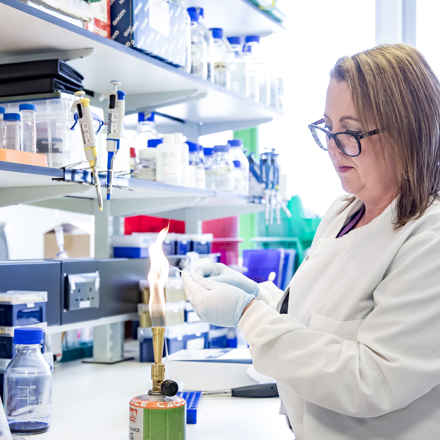Gene editing to treat inherited macular disease
Posted: Tuesday 05 July 2022
A research team is making strides in using gene-editing techniques to treat a rare, inherited form of macular disease.
Dr Amanda Carr and her colleagues at the UCL Institute of Ophthalmology have been looking into using gene-editing techniques to try and switch off the faulty gene in Bestrophinopathies, a rare group of inherited forms of macular disease.
Dr Carr has revealed the results from the Macular Society-funded project, which has seen her team explore ways to improve the health of the retinal pigment epithelium (RPE) cells, which nourish the light sensing photoreceptors which enable us to see.
Bestrophinopathies are caused by mistakes in the BEST1 gene, which provides instructions for making a protein called bestrophin-1. This protein is found in the RPE.
During the project the team was, for the first time, able to create RPE cells grown from skin cells taken from patients with the disease. These cells were then used to understand disease progression and to test potential treatments.
At a recent webinar on the topic, Dr Carr said that using stem cells from patients they have been able to see what these mutations are doing to the bestrophin-1 protein in those patients’ diseased RPE cells.
The team now plans to investigate these further, with an aim of developing treatments for BEST1-related diseases.
Just one of the treatments the team is exploring is the use of CRISPR-Cas9 gene editing.
Amanda said: “The biggest problem with inherited diseases is that the problem resides in DNA of the patient. If the DNA is giving cells the wrong instructions to make protein, the cell will continue to make a faulty copy of protein unless the DNA is fixed.”
CRISPR is a technology that cuts specific regions of DNA or RNA, like a precise molecular scissor. By looking for distinctive “spelling mistakes” that exist only in the faulty version of the gene.
Dr Carr’s team is currently testing the technique to cure dominant bestrophinopathies, by cutting out the faulty gene and leave the healthy one untouched. It is being tested using patients' skin cells, as well as stem cells and RPE cells created from patient skin cells.
Dr Carr said: “We’re still at the early stages of development for this therapeutic approach. We’re trying to prove this approach in a dish using cells from a patient, so we can understand the disease, we can see what the effects the mutation are having on the patients, and we can use the same cells to test that therapy to see whether our approach works.”
She added: “We thank the supporters of the Macular Society for generously funding our research, which has enabled an increased understanding of the impact of BEST1 mutations in the eye. This vital information will help us develop new approaches for treating inherited macular disease.”
